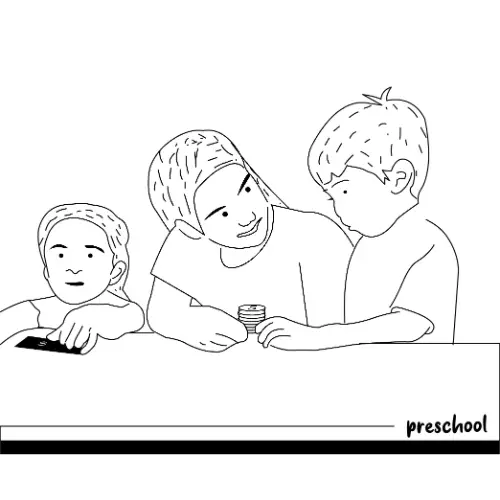Even though they are so young and naive, preschoolers have a lot on their plates. They are expected to know quite a bit by the end of the year about money and basic economic ideas and principles. According to the President’s Advisory Council on Financial Capability, pre-K students should learn about wants and needs, how you can buy things with money, how employment leads to making money, and the idea of waiting to buy products. Teachers can expand on these ideas in many ways, exposing kids to coins, bills, and the idea that currency has value. If you need a lesson plan today that hits on these crucial topics, visit our pre-K money lesson plans page to download all the pre-K materials you need.
Teachers and homeschoolers can supplement these core lesson plans with fun and exciting money activities and games, which are a great way to strengthen students’ understanding of financial concepts. Let’s dive into the best exercises for pre-K kids, broken down into skill categories!
Counting Coins Activities
Teachers can show preschoolers the different types of coins and also work on counting them. These activities boost their understanding of various currencies, setting students up for stronger arithmetic skills and coin recognition in the future.
Spin and Cover
Teachers can set up this activity quickly, using a spinner, a worksheet with pictures of coins, and sets of pennies, nickels, dimes, and quarters. Kids spin and place their currency on the corresponding image on their worksheets, building awareness of U.S. coins and helping teachers strengthen their money instruction.
Peter Pig’s Money Counter
This interactive online game will have your preschoolers jumping for joy as they count money, save, and distinguish between different denominations. They even get to buy items in a virtual store, allowing educators to show students how the exchange of money can work.
Name That Coin Game
Pre-K is an excellent time to learn the features of different coins: their names, appearances, symbols, and more. This printable activity lets kids practice identifying the standard coins, preparing them to learn more about money in kindergarten and beyond.
Going Fishing
Many children love to go fishing, and this game combines angling with coin recognition, giving educators an excellent activity for their young students. You can make fishing poles easily with a straw or stick and magnets, having kids pick up the type of coin you say aloud.
Dump the Jar Activity
This fun little game gives teachers an excuse to mess up their rooms and have kids help clean it up! You fill a jar with various coins, dump it on the floor, and students rush to gather and count specific coins: whoever has the most pennies, nickels, dimes, or quarters in the end wins, depending on how you set up the rules at the start.
Money Maze
Teachers and homeschoolers love no-prep worksheets that support student learning and build upon concepts they have learned in class. These money maze printables have preschoolers tracing their way through a coin maze by staying on a path of pennies or a line of dimes, moving from top to bottom to get out of the labyrinth. They are a great way to unlock kids’ logic, creativity, and coin recognition skills.
Money Value Activities
As students learn to identify different coins, the next step is to understand their value. These games and exercises will get your students on track to know the value of our money, whether they are role-playing or pretending to be professionals handling cash.
Virtual Grocery Store
This activity takes a little more effort to set up, as educators will need to supply toy cash registers, fake food items, and price tags to label products. Kids take turns playing cashiers and customers, using play money to buy things in the store while learning about pricing and the value of different currencies.
Pretend Dinner
Set up a pretend restaurant if you want a project to keep your kids engaged. Have students make up menus and pretend to serve the food to their customers while providing prices for each dish – giving teachers an excellent chance to show kids how food costs money and how much is a reasonable amount to charge.
The Trade Game
Have partners sit across from each other with a pile of coins of different denominations, with various amounts of nickels, pennies, quarters, and dimes. They take turns trading groups of coins, deciding if the exchange is fair or not, by counting the value of the money (so, trading five dimes is fair for two quarters, but five pennies is not equal to a dime).
Needs and Wants Activities
Kids of all ages have needs and wants, and teachers can explain that adults have these wishes, too, which factor into how they spend, save, and invest in the future. These activities do a great job of showing the difference between the two categories of needs and wants and why it matters as kids get older.
Pet Needs and Wants
Educators can set up large pieces of butcher paper with several pictures of things you would give to your pet, including dog food, blankets, sweaters, toys, water bowls, and medicine. Have your learners separate the pictures into either wants and needs for their pets, describing that cats and dogs need specific things to live, and other items only make them a little more comfortable.
Bingo!
The good thing about Bingo is that you can use this format to review many different concepts, and money education is no exception. You can fill in a mixture of wants and needs, labeling each picture as one or the other, and have students X out their Bingo cards as you call different items out loud, making for a fun and engaging activity.
Employment and Career Activities
People get paid for working, and preschool is the perfect time for kids to learn this idea. Career exploration is ideal for showing them how jobs lead to money. You can approach this unit in many ways, but these games and activities will surely get your kids in the right mindset.
Pretend Payday Activities
Educators can develop many variations of these activities, but one way to approach it is to have students choose a retail job as a pretend career. They can run grocery stores, clothing stores, sporting goods stores, or anything else, selling their pretend merchandise and making their store buzz. After they reach specific milestones, they get to take a paycheck home with them, showing them the reward of hard work.
Magazines and Books about Careers
Students love to listen along to all kinds of stories and books at this age, so why not mix in some about careers? You never know what entrepreneurial potential is in these students; it is never too early to get them interested in what they will do when they grow up.
Sesame Street Videos for Pre-K Students
The Sesame Street website has many educational videos you can use to supplement your core lesson plans, which are dedicated to financial education and money awareness for young students. These short and entertaining videos cover various economic topics and keep kids wanting to learn more about money.
Activities that Show Money is a Necessity
We need money in our society. All the things we want and need cost money, and learning about the importance of money is vital for your preschoolers. These activities hammer that point home and show kids the prevalence of transactions, buying, and selling.
Guess the Price Game
You can develop this game on your own time quickly, simply drawing pictures of several items you would find in the grocery store. Have each child guess the price of each product, then either go to the store or check online for the actual pricing of those items. The winner of the game is the person who gets closest to the actual cost of the products.
Set Up an Entire Class Store
This activity takes a bit of extra elbow grease, but the payoffs are well worth it. You can set aside a section of the room to be the class “store,” with cash registers, shelves, products, shopping baskets, and anything else you can come up with for student participation. Kids set prices, earn money to spend in the store, perform transactions with classmates, and count up coins to reach specific totals, giving them a comprehensive way to understand the value and importance of money.
Coin Sorting Mats
You can create your own coin sorting mats using various materials, labeling each quadrant with the name of a coin: pennies, nickels, dimes, and quarters. Kids grab a pile of cash and sort it into sections on the mat while teachers emphasize the names, values, and essential uses of each (you can show students that quarters are more valuable than pennies, for example, and describe the types of things you could buy with different coins).


